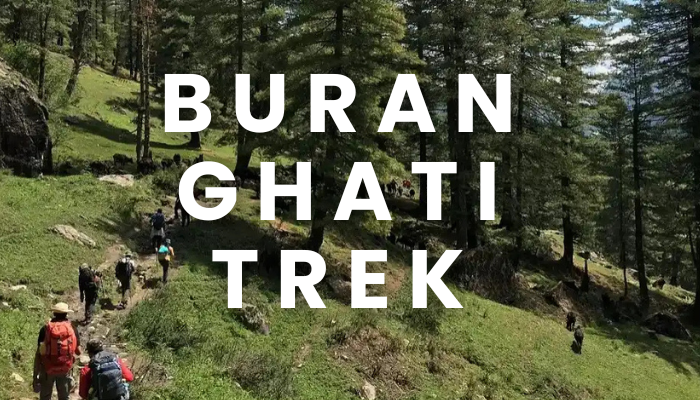The Buran Ghati trek is one of the best treks in Himachal Pradesh. It’s one of the most beautiful and varied routes you can find. The trek sits in the Pabbar Valley area of the Shimla district. It links the old village of Janglik with the distant Kinnaur valley village of Barua.
The trek mixes thick green meadows, snow crossings, high mountain camps, and a thrilling descent from the pass. The trail goes up to about 15,000 feet. This makes it a real high-mountain experience. Buran Ghati is not too easy. It is not too hard either. It gives you a great balance of beauty, village life, and adventure.
Highlights of Buran Ghati Trek
This route is known because the scenery changes so much. It begins with pine forests and old wooden Himachali houses near Janglik. Then you walk through green meadows like Dayara and Litham. After that, the land turns into a dramatic mix of rock and snow near the pass. The best part for most people is the steep snow wall at the Buran Pass. You have to rappel down or slide down it, depending on the season. That section is what makes the trek technically exciting.
You will see clear mountain streams. You will see peaks reflecting in Chandranahan Lake. And you will camp quietly under big, open skies. Every part of the trail is different. It goes from easy village paths to wild, high alpine land beyond Litham.
Best Time To Do Buran Ghati Trek
The best time to do the Buran Ghati Trek is from mid-May to late June. Or you can go from September to early October.
In May and June, there is still snow on the high slopes. This makes a mix of green valleys and white ridges. The weather stays cool. Days are around 10 to 15∘C. Nights get close to freezing near the pass. The snow crossing at the top makes for a strong adventure feeling during this time.
Starting in September, after the monsoon rains stop, the sky is clear. The valleys look freshly green. The trails are drier and much cleaner. The views of the Dhauladhar and Kinner Kailash ranges are perfect in autumn. But nights get colder in October. The season usually closes then with the first snow.
Both windows are good. The choice depends on what you want. Go in early summer for a snow adventure. Go in autumn for stable weather and crisp, clear mountain views.
Difficulty Level of Buran Ghati Trek
Buran Ghati is a moderate to difficult trek. It is not for new trekkers.
The steep climb to the pass is the main reason for the difficulty. The pass day is long. It requires good fitness and some past trekking experience. You will walk six to eight hours most days. The climb from Litham to the pass really tests your endurance. The snow wall descent can be technical. It is especially tricky when the ice is firm. You should be comfortable walking on snow. Make sure you train for strength and cardio before you go.
This trek demands effort. But it gives you huge rewards. You get one of the most complete Himalayan experiences. You see forests, grasslands, glacial areas, and remote valleys all in one trip.
Itinerary
The trek usually takes about six to eight days. The time depends on how fast you walk and where you start.
Day 1 is a drive from Shimla to Janglik (9,200 feet). The drive is about 150 km. It goes through Rohru and Tangnu, following the Pabbar River. The drive takes about eight hours. You stay overnight in Janglik.
Day 2 you trek from Janglik to Dayara Thach (11,000 feet, 6 km). The trail climbs easily through pine and oak forests. You pass small farms and wooden houses. Then you reach the open meadows of Dayara.
Day 3 you trek from Dayara to Litham (11,800 feet, 4 km). The land opens up more. You cross small streams and walk beside the Pabbar river valley. Litham gives you wide views of the Gunas Pass.
Day 4 is a day hike to Chandranahan Lake (13,900 feet, 6 km round trip). This is a glacial lake fed by melting snow. The climb is steep but short. You come back to Litham by afternoon to help your body get used to the altitude.
Day 5 you trek from Litham to Dunda (13,500 feet, 5 km). The trail turns rocky and alpine. You will walk through boulder areas and snow patches. Dunda is the camp before crossing the pass. You can see the snowline clearly from here.
Day 6 you cross Buran Ghati (15,000 feet) and go down to River Camp (11,000 feet, 7 km). You must start early to climb the pass. The climb is steep. It may have snow. From the top, you go down carefully using ropes or sliding. The valley opens beautifully as you move down.
Day 7 you trek from River Camp to Barua village (6,000 feet, 6 km). Then you drive to Shimla (200 km). You walk through apple orchards and small villages before reaching Barua. Then you take a long drive back to Shimla. This is the end of the trek.
Conclusion
Buran Ghati is a trek that feels complete. It connects two valleys that look totally different. It shows you everything the Himalayas have. The forests, meadows, snow covered mountain . It’s a good challenge for trekkers who want to go past the easy trails. It gives you a true mountain journey.
If you want more high-altitude adventures, look into other treks. Pin Parvati Pass, Miyar Valley, Pangarchulla Peak Trek and Bali Pass are great options. They offer the same mix of tough challenge and amazing beauty.



